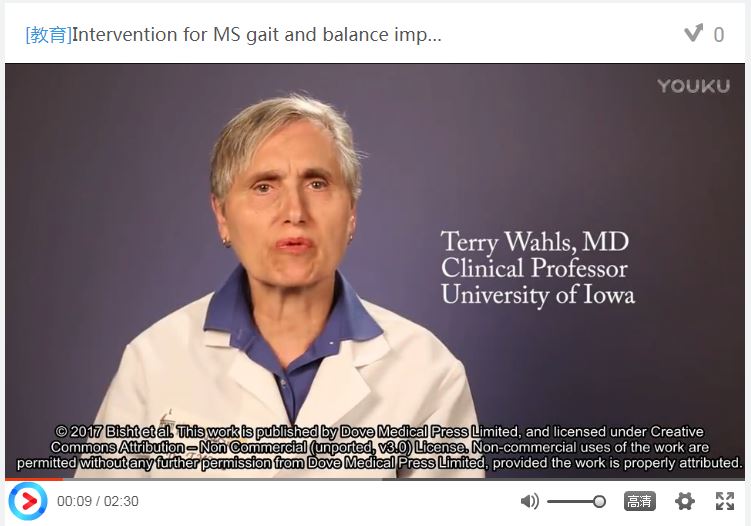9 0 8 0 2
论文已发表
注册即可获取德孚的最新动态
IF 收录期刊
- 2.6 Breast Cancer (Dove Med Press)
- 3.9 Clin Epidemiol
- 3.3 Cancer Manag Res
- 3.9 Infect Drug Resist
- 3.6 Clin Interv Aging
- 4.8 Drug Des Dev Ther
- 2.8 Int J Chronic Obstr
- 8.0 Int J Nanomed
- 2.3 Int J Women's Health
- 3.2 Neuropsych Dis Treat
- 4.0 OncoTargets Ther
- 2.2 Patient Prefer Adher
- 2.8 Ther Clin Risk Manag
- 2.7 J Pain Res
- 3.3 Diabet Metab Synd Ob
- 4.3 Psychol Res Behav Ma
- 3.4 Nat Sci Sleep
- 1.9 Pharmgenomics Pers Med
- 3.5 Risk Manag Healthc Policy
- 4.5 J Inflamm Res
- 2.3 Int J Gen Med
- 4.1 J Hepatocell Carcinoma
- 3.2 J Asthma Allergy
- 2.3 Clin Cosmet Investig Dermatol
- 3.3 J Multidiscip Healthc

Effects of a multimodal intervention on gait and balance of subjects with progressive multiple sclerosis: a prospective longitudinal pilot study
Authors Bisht B, Darling WG, White EC, White KA, Shivapour ET, Zimmerman MB, Wahls TL
Received 28 November 2016
Accepted for publication 30 March 2017
Published 26 June 2017 Volume 2017:7 Pages 79—93
DOI https://doi.org/10.2147/DNND.S128872
Checked for plagiarism Yes
Review by Single-blind
Peer reviewers approved by Dr Colin Mak
Peer reviewer comments 3
Editor who approved publication: Prof. Dr. Thomas Müller
Purpose: To
investigate the effects of a multimodal intervention including a modified
Paleolithic diet, nutritional supplements, stretching, strengthening exercises
with electrical stimulation of trunk and lower limb muscles, meditation and
massage on walking performance and balance of subjects with progressive
multiple sclerosis (MS).
Materials and methods: Twenty subjects with mean (standard deviation) age of
51.7 (6.4) years and Expanded Disability Status Scale score of 6.2 (1)
participated in a 12-month study. Assessments were completed at baseline, 3, 6,
9, and 12 months.
Results: The entire cohort did not show significant changes in
any of the assessments over 12 months except higher speed of walking
toward the 10 feet mark during timed up and go (TUG) test at 6 months compared
with baseline (mean change 7.9 cm/s [95% confidence interval {CI}]: 0.3, 15.2; p =0.041). Sub-group analysis
revealed that 50% subjects (n=10) showed decrease in TUG time from baseline to
at least 3 of 4 time-points post-intervention and were considered as responders
(TUG-Res), the remaining 10 subjects were considered as nonresponders
(TUG-NRes). Over 12 months, TUG-Res showed decreased mean TUG time by 31% (95%
CI: −52%, −2%), increased median Berg Balance Scale scores (42 to 47), 30%
increase in mean timed 25-foot walk speed (>20% considered clinically
significant) and increased speed of walk toward 10 feet mark during TUG by 11.6
cm/s (95% CI: −3.0, 25.9) associated with increases in step lengths and
decrease in step duration. TUG-NRes showed deterioration in walking ability
over 12 months. Comparison of TUG-Res and TUG-NRes showed no significant
differences in adherence to intervention but better stride duration and longer
step length at baseline for TUG-Res than for TUG-NRes (p <0.05).
Conclusion: A multimodal lifestyle intervention may improve
walking performance and balance in subjects with progressive MS who have
mild-to-moderate gait impairment, whereas subjects with severe gait impairments
may not respond to this intervention. Future trials should assess effects of
this intervention in subjects with MS during early stages of the disease.
Keywords: multiple sclerosis, Paleolithic diet,
exercise, neuromuscular electrical stimulation, gait, balance
摘要视频链接:Intervention for MS gait and
balance impairment
